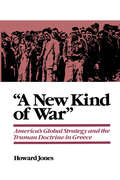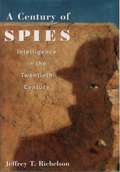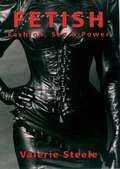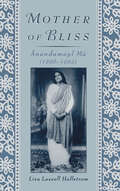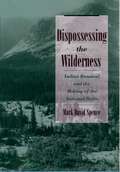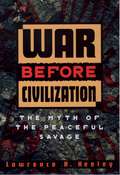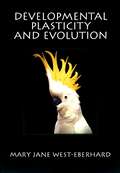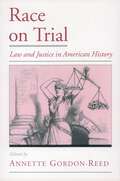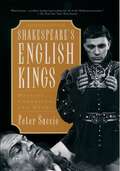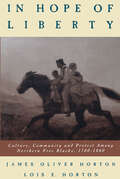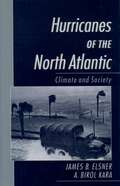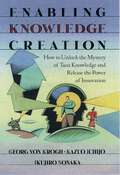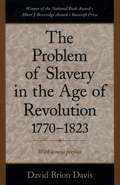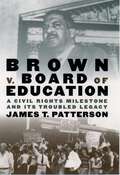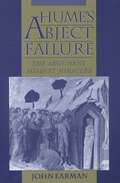- Table View
- List View
"A New Kind of War": America's Global Strategy and the Truman Doctrine in Greece
by Howard JonesAmerica's experience in Greece has often been cited as a model by those later policymakers in Washington who regard the involvement as a "victory" for American foreign policy. Indeed, President Johnson and others referred to Greece as the model for America's deepening involvement in Vietnam during the mid-1960's. Greece became the battlefield for a new kind of war--one that included the use of guerrilla warfare, propaganda, war in the shadows, terror tactics and victory based on outlasting the enemy. It was also a test before the world of America's resolve to protect the principle of self-determination. Jones argues that American policy towards Greece was the focal point in the development of a global strategy designed to combat totalitarianism. He also argues that had the White House and others drawn the real "lessons" from the intervention in Greece, the decisions regarding Vietnam might have been more carefully thought out.
A Century of Spies: Intelligence in the Twentieth Century
by Jeffery T. RichelsonHere is the ultimate inside history of twentieth-century intelligence gathering and covert activity. Unrivalled in its scope and as readable as any spy novel, A Century of Spies travels from tsarist Russia and the earliest days of the British Secret Service to the crises and uncertainties of today's post-Cold War world, offering an unsurpassed overview of the role of modern intelligence in every part of the globe. From spies and secret agents to the latest high-tech wizardry in signals and imagery surveillance, it provides fascinating, in-depth coverage of important operations of United States, British, Russian, Israeli, Chinese, German, and French intelligence services, and much more. All the key elements of modern intelligence activity are here. An expert whose books have received high marks from the intelligence and military communities, Jeffrey Richelson covers the crucial role of spy technology from the days of Marconi and the Wright Brothers to today's dazzling array of Space Age satellites, aircraft, and ground stations. He provides vivid portraits of spymasters, spies, and defectors--including Sidney Reilly, Herbert Yardley, Kim Philby, James Angleton, Markus Wolf, Reinhard Gehlen, Vitaly Yurchenko, Jonathan Pollard, and many others. Richelson paints a colorful portrait of World War I's spies and sabateurs, and illuminates the secret maneuvering that helped determine the outcome of the war on land, at sea, and on the diplomatic front; he investigates the enormous importance of intelligence operations in both the European and Pacific theaters in World War II, from the work of Allied and Nazi agents to the "black magic" of U.S. and British code breakers; and he gives us a complete overview of intelligence during the length of the Cold War, from superpower espionage and spy scandals to covert action and secret wars. A final chapter probes the still-evolving role of intelligence work in the new world of disorder and ethnic conflict, from the high-tech wonders of the Gulf War to the surprising involvement of the French government in industrial espionage. Comprehensive, authoritative, and addictively readable, A Century of Spies is filled with new information on a variety of subjects--from the activities of the American Black Chamber in the 1920s to intelligence collection during the Cuban missile crisis to Soviet intelligence and covert action operations. It is an essential volume for anyone interested in military history, espionage and adventure, and world affairs.
Fetish: Fashion, Sex & Power
by Valerie SteeleKinky boots, corsets, underwear as outerwear, second-skin garments of rubber and leather, uniforms, body piercing.... Today everything from a fetishist's dream appears on the fashion runways. Although some people regard fetish fashion as exploitative and misogynistic, others interpret it as a positive Amazonian statement--couture Catwoman. But the connection between fashion and fetishism goes far beyond a few couture collections. For the past thirty years, the iconography of sexual fetishism has been increasingly assimilated into popular culture. Before Michelle Pfeiffer's Catwoman, there was Mrs. Peel, heroine of the 1960s television show "The Avengers," who wore a black leather catsuit modeled on a real fetish costume. Street styles like punk and the gay "leatherman" look also testify to the influence of fetishism. The concept of fetishism has recently assumed a growing importance in critical thinking about the cultural construction of sexuality. Yet until now no scholar with an in-depth knowledge of fashion history has studied the actual clothing fetishes themselves. Nor has there been a serious exploration of the historical relationship between fashion and fetishism, although erotic styles have changed significantly and "sexual chic" has become increasingly conspicuous. Cultural historian Valerie Steele has devoted much of her career to the study of the relationship between clothing and sexuality, and is uniquely qualified to write this book. Marshalling a dazzling array of evidence from pornography, psychology, and history, as well as interviews with individuals involved in sexual fetishism, sadomasochism, and cross-dressing, Steele illuminates the complex relationship between appearance and identity. Based on years of research, her book Fetish: Fashion, Sex & Power explains how a paradigm shift in attitudes toward sex and gender has given rise to the phenomenon of fetish fashion. "Steele is to fetish dressing what Anne Rice is to vampires," writes Christa Worthington of Elle magazine, "the intellectual interpreter of...wishes beyond our ken." According to Steele, fetishism shows how human sexuality is never just a matter of doing what comes naturally; fantasy always plays an important role. Steele provides provocative answers to such questions as: Why is black regarded as the sexiest color? Is fetishizing the norm for males? Does fetish fashion reflect a fear of AIDS? And why do so many people love shoes?
Mother of Bliss: =Anandamay=i M=a
by Lisa Lassell HallstromThis book examines the life of =Anandamay=i M=a, one of the most renowned Hindu holy women of modern times. Lisa Hallstrom paints a vivid portrait of this extraordinary woman, her ideas, and her continuing influence. In the process, the author sheds new light on important themes of Hindu religious life, including the centrality of the guru, the influence of living saints, and the apparent paradox of the worship of the divine feminine and the status of Hindu women.
Dispossessing the Wilderness: Indian Removal and the Making of the National Parks
by Mark David SpenceNational parks like Yellowstone, Yosemite, and Glacier preserve some of this country's most cherished wilderness landscapes. While visions of pristine, uninhabited nature led to the creation of these parks, they also inspired policies of Indian removal. By contrasting the native histories of these places with the links between Indian policy developments and preservationist efforts, this work examines the complex origins of the national parks and the troubling consequences of the American wilderness ideal. The first study to place national park history within the context of the early reservation era, it details the ways that national parks developed into one of the most important arenas of contention between native peoples and non-Indians in the twentieth century.
War before Civilization
by Lawrence H. KeeleyThe myth of the peace-loving "noble savage" is persistent and pernicious. Indeed, for the last fifty years, most popular and scholarly works have agreed that prehistoric warfare was rare, harmless, unimportant, and, like smallpox, a disease of civilized societies alone. Prehistoric warfare, according to this view, was little more than a ritualized game, where casualties were limited and the effects of aggression relatively mild. Lawrence Keeley's groundbreaking War Before Civilization offers a devastating rebuttal to such comfortable myths and debunks the notion that warfare was introduced to primitive societies through contact with civilization (an idea he denounces as "the pacification of the past"). Building on much fascinating archeological and historical research and offering an astute comparison of warfare in civilized and prehistoric societies, from modern European states to the Plains Indians of North America, War Before Civilization convincingly demonstrates that prehistoric warfare was in fact more deadly, more frequent, and more ruthless than modern war. To support this point, Keeley provides a wide-ranging look at warfare and brutality in the prehistoric world. He reveals, for instance, that prehistorical tactics favoring raids and ambushes, as opposed to formal battles, often yielded a high death-rate; that adult males falling into the hands of their enemies were almost universally killed; and that surprise raids seldom spared even women and children. Keeley cites evidence of ancient massacres in many areas of the world, including the discovery in South Dakota of a prehistoric mass grave containing the remains of over 500 scalped and mutilated men, women, and children (a slaughter that took place a century and a half before the arrival of Columbus). In addition, Keeley surveys the prevalence of looting, destruction, and trophy-taking in all kinds of warfare and again finds little moral distinction between ancient warriors and civilized armies. Finally, and perhaps most controversially, he examines the evidence of cannibalism among some preliterate peoples. Keeley is a seasoned writer and his book is packed with vivid, eye-opening details (for instance, that the homicide rate of prehistoric Illinois villagers may have exceeded that of the modern United States by some 70 times). But he also goes beyond grisly facts to address the larger moral and philosophical issues raised by his work. What are the causes of war? Are human beings inherently violent? How can we ensure peace in our own time? Challenging some of our most dearly held beliefs, Keeley's conclusions are bound to stir controversy.
Bach's Works for Solo Violin: Style, Structure, Performance
by Joel LesterJ. S. Bach's sonatas and partitas for solo violin have been central to the violin repertoire since the mid-eighteenth century. This engaging volume is the first comprehensive exploration of the place of these works within Bach's music: it focuses on their structural and stylistic features as they have been perceived since their creation. Joel Lester, a highly regarded scholar, teacher, violinist, and administrator, combines an analytical study, a full historical guide, and an insightful introduction to Bach's style. Individual movements are related to comparable movements by Bach in other media and are differentiated from superficially similar works from later eras. Lester employs descriptions of historical and contemporary recordings, as well as accounts of nineteenth-century performances and commentaries on historical editions, to explore these works as they evolved through the centuries. Wherever possible, he uses analytic tools culled from eighteenth-century ideas, key notions originally developed for the specific purpose of describing the repertoire under consideration. Beginning with an overview of the solo violin music's place within Bach's oeuvre, this study takes the Sonata No. 1 in G minor as the paradigm of Bach's compositional strategy, examining each movement in detail before enlarging the discussion to cover parallel and contrasting features of the A-minor and C-minor sonatas. Next, a chapter is devoted to the three partitas and their roots in various dance-music traditions. The book concludes with a summary of form, style, and rhetoric in Bach's music, in which Lester muses on these masterpieces with an overall command of the music, criticism, and history of the 1700s that is quite rare among scholars. A novel and unprecedented investigation of a particular portion of Bach's accomplishment and a particular aspect of his universal appeal, Bach's Works for Solo Violin will help violinists, students, scholars, and other listeners develop a deeper personal involvement with these wonderful pieces.
Developmental Plasticity and Evolution
by Mary Jane West-EberhardThe first comprehensive synthesis on development and evolution: it applies to all aspects of development, at all levels of organization and in all organisms, taking advantage of modern findings on behavior, genetics, endocrinology, molecular biology, evolutionary theory and phylogenetics to show the connections between developmental mechanisms and evolutionary change. This book solves key problems that have impeded a definitive synthesis in the past. It uses new concepts and specific examples to show how to relate environmentally sensitive development to the genetic theory of adaptive evolution and to explain major patterns of change. In this book development includes not only embryology and the ontogeny of morphology, sometimes portrayed inadequately as governed by "regulatory genes," but also behavioral development and physiological adaptation, where plasticity is mediated by genetically complex mechanisms like hormones and learning. The book shows how the universal qualities of phenotypes--modular organization and plasticity--facilitate both integration and change. Here you will learn why it is wrong to describe organisms as genetically programmed; why environmental induction is likely to be more important in evolution than random mutation; and why it is crucial to consider both selection and developmental mechanism in explanations of adaptive evolution. This book satisfies the need for a truly general book on development, plasticity and evolution that applies to living organisms in all of their life stages and environments. Using an immense compendium of examples on many kinds of organisms, from viruses and bacteria to higher plants and animals, it shows how the phenotype is reorganized during evolution to produce novelties, and how alternative phenotypes occupy a pivotal role as a phase of evolution that fosters diversification and speeds change. The arguments of this book call for a new view of the major themes of evolutionary biology, as shown in chapters on gradualism, homology, environmental induction, speciation, radiation, macroevolution, punctuation, and the maintenance of sex. No other treatment of development and evolution since Darwin's offers such a comprehensive and critical discussion of the relevant issues. Developmental Plasticity and Evolution is designed for biologists interested in the development and evolution of behavior, life-history patterns, ecology, physiology, morphology and speciation. It will also appeal to evolutionary paleontologists, anthropologists, psychologists, and teachers of general biology.
Enzymatic Reaction Mechanisms
by Perry A. Frey Adrian D. HegemanBooks dealing with the mechanisms of enzymatic reactions were written a generation ago. They included volumes entitled Bioorganic Mechanisms, I and II by T.C. Bruice and S.J. Benkovic, published in 1965, the volume entitled Catalysis in Chemistry and Enzymology by W.P. Jencks in 1969, and the volume entitled Enzymatic Reaction Mechanisms by C.T. Walsh in 1979. The Walsh book was based on the course taught by W.P. Jencks and R.H. Abeles at Brandeis University in the 1960's and 1970's. By the late 1970's, much more could be included about the structures of enzymes and the kinetics and mechanisms of enzymatic reactions themselves, and less emphasis was placed on chemical models. Walshs book was widely used in courses on enzymatic mechanisms for many years. Much has happened in the field of mechanistic enzymology in the past 15 to 20 years. Walshs book is both out-of-date and out-of-focus in todays world of enzymatic mechanisms. There is no longer a single volume or a small collection of volumes to which students can be directed to obtain a clear understanding of the state of knowledge regarding the chemicals mechanisms by which enzymes catalyze biological reactions. There is no single volume to which medicinal chemists and biotechnologists can refer on the subject of enzymatic mechanisms. Practitioners in the field have recognized a need for a new book on enzymatic mechanisms for more than ten years, and several, including Walsh, have considered undertaking to modernize Walshs book. However, these good intentions have been abandoned for one reason or another. The great size of the knowledge base in mechanistic enzymology has been a deterrent. It seems too large a subject for a single author, and it is difficult for several authors to coordinate their work to mutual satisfaction. This text by Perry A. Frey and Adrian D. Hegeman accomplishes this feat, producing the long-awaited replacement for Walshs classic text.
Race on Trial: Law and Justice in American History (Viewpoints on American Culture)
by Annette Gordon-ReedThis book of twelve original essays will bring together two themes of American culture: law and race. The essays fall into four groups: cases that are essential to the history of race in America; cases that illustrate the treatment of race in American history; cases of great fame that became the trials of the century of their time; and cases that made important law. Some of the cases discussed include Amistad, Dred Scott, Plessy v. Ferguson, Scottsboro, Korematsu v. US, Brown v. Board, Loving v. Virginia, Regents v. Bakke, and OJ Simpson. All illustrate how race often determined the outcome of trials, and how trials that confront issues of racism provide a unique lens on American cultural history. Cases include African-Americans, Asian-Americans, and Caucasians. Contributors include a mix of junior and senior scholars in law schools and history departments.
William Osler: A Life in Medicine
by Michael BlissWilliam Osler was born in a parsonage in backwoods Canada on July 12, 1849. In a life lasting seventy years, he practiced, taught, and wrote about medicine at Canada's McGill University, America's Johns Hopkins University, and finally as Regius Professor at Oxford. At the time of his death in England in 1919, many considered him to be the greatest doctor in the world. Osler, who was a brilliant, innovative teacher and a scholar of the natural history of disease, revolutionized the art of practicing medicine at the bedside of his patients. He was idolized by two generations of medical students and practitioners for whom he came to personify the ideal doctor. But much more than a physician, Osler was a supremely intelligent humanist. In both his writings and his personal life, and through the prism of the tragedy of the Great War, he embodied the art of living. It was perhaps his legendary compassion that elevated his healing talents to an art form and attracted to his private practice students, colleagues, poets (Walt Whitman for example) politicians, royalty, and nameless ordinary people with extraordinary conditions. William Osler's life lucidly illuminates the times in which he lived. Indeed, this is a book not only about the evolution of modern medicine, the training of doctors, holism in medical thought, and the doctor-patient relationship, but also about humanism, Victorianism, the Great War, and much else. Meticulously researched, drawing on many new sources and offering new interpretations, William Osler: A Life in Medicine brings to life both a fascinating man and the formative age of twentieth-century medicine. It is a classic biography of a classic life, both authoritative and highly readable.
In Hope of Liberty: Culture, Community and Protest Among Northern Free Blacks, 1700-1860
by Lois E. Horton James O. HortonPrince Hall, a black veteran of the American Revolution, was insulted and disappointed but probably not surprised when white officials refused his offer of help. He had volunteered a troop of 700 Boston area blacks to help quell a rebellion of western Massachusetts farmers led by Daniel Shays during the economic turmoil in the uncertain period following independence. Many African Americans had fought for America's liberty and their own in the Revolution, but their place in the new nation was unresolved. As slavery was abolished in the North, free blacks gained greater opportunities, but still faced a long struggle against limits to their freedom, against discrimination, and against southern slavery. The lives of these men and women are vividly described in In Hope of Liberty, spanning the 200 years and eight generations from the colonial slave trade to the Civil War. In this marvelously peopled history, James and Lois Horton introduce us to a rich cast of characters. There are familiar historical figures such as Crispus Attucks, a leader of the Boston Massacre and one of the first casualties of the American Revolution; Sojourner Truth, former slave and eloquent antislavery and women's rights activist whose own family had been broken by slavery when her son became a wedding present for her owner's daughter; and Prince Whipple, George Washington's aide, easily recognizable in the portrait of Washington crossing the Delaware River. And there are the countless men and women who struggled to lead their daily lives with courage and dignity: Zilpha Elaw, a visionary revivalist who preached before crowds of thousands; David James Peck, the first black to graduate from an American medical school in 1848; Paul Cuffe, a successful seafaring merchant who became an ardent supporter of the black African colonization movement; and Nancy Prince, at eighteen the effective head of a scattered household of four siblings, each boarded in different homes, who at twenty-five was formally presented to the Russian court. In a seamless narrative weaving together all these stories and more, the Hortons describe the complex networks, both formal and informal, that made up free black society, from the black churches, which provided a sense of community and served as a training ground for black leaders and political action, to the countless newspapers which spoke eloquently of their aspirations for blacks and played an active role in the antislavery movement, to the informal networks which allowed far-flung families to maintain contact, and which provided support and aid to needy members of the free black community and to fugitives from the South. Finally, they describe the vital role of the black family, the cornerstone of this variegated and tightly knit community In Hope of Liberty brilliantly illuminates the free black communities of the antebellum North as they struggled to reconcile conflicting cultural identities and to work for social change in an atmosphere of racial injustice. As the black community today still struggles with many of the same problems, this insightful history reminds us how far we have come, and how far we have yet to go.
Hurricanes of the North Atlantic: Climate and Society
by James B. Elsner A. Birol KaraCalled the greatest storms on the planet, hurricanes of the North Atlantic Ocean often cause tremendous social and economic upheaval in the United States, Mexico, and the Caribbean. And with the increasing development of coastal areas, the impact of these storms will likely increase. This book provides a comprehensive analysis of North Atlantic hurricanes and what they mean to society. It is intended as an intermediary between hurricane climate research and the users of hurricane information. Topics include the climatology of tropical cyclones in general and those of the North Atlantic in particular; the major North Atlantic hurricanes, focusing on U.S. landfalling storms; the prediction models used in forecasting; and societal vulnerability to hurricanes, including ideas for modeling the relationship between climatological data and analysis in the social and economic sciences.
Enabling Knowledge Creation: How to Unlock the Mystery of Tacit Knowledge and Release the Power of Innovation
by Ikujiro Nonaka Kazuo Ichijo Georg von KroghWhen The Knowledge-Creating Company (OUP; nearly 40,000 copies sold) appeared, it was hailed as a landmark work in the field of knowledge management. Now, Enabling Knowledge Creation ventures even further into this all-important territory, showing how firms can generate and nurture ideas by using the concepts introduced in the first book. Weaving together lessons from such international leaders as Siemens, Unilever, Skandia, and Sony, along with their own first-hand consulting experiences, the authors introduce knowledge enabling--the overall set of organizational activities that promote knowledge creation--and demonstrate its power to transform an organization's knowledge into value-creating actions. They describe the five key "knowledge enablers" and outline what it takes to instill a knowledge vision, manage conversations, mobilize knowledge activists, create the right context for knowledge creation, and globalize local knowledge. The authors stress that knowledge creation must be more than the exclusive purview of one individual--or designated "knowledge" officer. Indeed, it demands new roles and responsibilities for everyone in the organization--from the elite in the executive suite to the frontline workers on the shop floor. Whether an activist, a caring expert, or a corporate epistemologist who focuses on the theory of knowledge itself, everyone in an organization has a vital role to play in making "care" an integral part of the everyday experience; in supporting, nurturing, and encouraging microcommunities of innovation and fun; and in creating a shared space where knowledge is created, exchanged, and used for sustained, competitive advantage. This much-anticipated sequel puts practical tools into the hands of managers and executives who are struggling to unleash the power of knowledge in their organization.
The Problem of Slavery in the Age of Revolution, 1770-1823
by David Brion DavisDavid Brion Davis's books on the history of slavery reflect some of the most distinguished and influential thinking on the subject to appear in the past generation. The Problem of Slavery in the Age of Revolution, the sequel to Davis's Pulitzer Prize-winning The Problem of Slavery in Western Culture and the second volume of a proposed trilogy, is a truly monumental work of historical scholarship that first appeared in 1975 to critical acclaim both academic and literary. This reprint of that important work includes a new preface by the author, in which he situates the book's argument within the historiographic debates of the last two decades.
Brown v. Board of Education: A Civil Rights Milestone and Its Troubled Legacy (Pivotal Moments in American History)
by James T. Patterson2004 marks the fiftieth anniversary of the Supreme Court's unanimous decision to end segregation in public schools. Many people were elated when Supreme Court Chief Justice Earl Warren delivered Brown v. Board of Education of Topeka in May 1954, the ruling that struck down state-sponsored racial segregation in America's public schools. Thurgood Marshall, chief attorney for the black families that launched the litigation, exclaimed later, "I was so happy, I was numb." The novelist Ralph Ellison wrote, "another battle of the Civil War has been won. The rest is up to us and I'm very glad. What a wonderful world of possibilities are unfolded for the children!" Here, in a concise, moving narrative, Bancroft Prize-winning historian James T. Patterson takes readers through the dramatic case and its fifty-year aftermath. A wide range of characters animates the story, from the little-known African Americans who dared to challenge Jim Crow with lawsuits (at great personal cost); to Thurgood Marshall, who later became a Justice himself; to Earl Warren, who shepherded a fractured Court to a unanimous decision. Others include segregationist politicians like Governor Orval Faubus of Arkansas; Presidents Eisenhower, Johnson, and Nixon; and controversial Supreme Court justices such as William Rehnquist and Clarence Thomas. Most Americans still see Brown as a triumph--but was it? Patterson shrewdly explores the provocative questions that still swirl around the case. Could the Court--or President Eisenhower--have done more to ensure compliance with Brown? Did the decision touch off the modern civil rights movement? How useful are court-ordered busing and affirmative action against racial segregation? To what extent has racial mixing affected the academic achievement of black children? Where indeed do we go from here to realize the expectations of Marshall, Ellison, and others in 1954?
